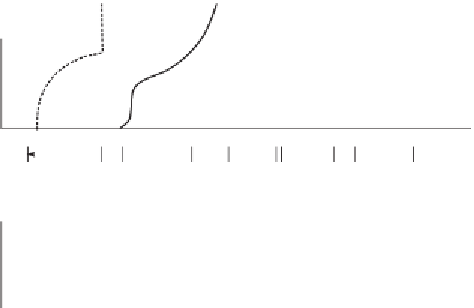Geoscience Reference
In-Depth Information
daytime
400 W m
-2
1 m s
-1
3 K2 hPa
10 ppmv
nighttime
Foliage
density
Radiation
Wind speed
Temperature
Humidity
CO
2
Figure 6.20
Canopy proiles of foliage density, net radiation, wind speed, tempera-
ture, humidity and CO
2
concentration during daytime (top) and night time (bottom).
The arrows indicate the direction of transport. Note that in the daytime igure the in-
canopy arrows are deliberately omitted owing to the possibility of counter-gradient
transport (see later). (After Monteith and Unsworth,
2008
.)
6.6.1 Radiation
Shortwave Radiation
Leaves absorb radiation, but they relect and transmit radiation as well. The optical
properties depend on the wavelength of the light, as can be seen in
Figure 6.21
. The
strong absorption in the visible part is due to chlorophyll, with a small dip around
520
μ
m, which corresponds to green (thus leaves relect green light effectively, hence
their green colour). Absorption at wavelengths around 2
μ
m is due to absorption by
water. The spectral properties of the leaves cause a change in the spectral composi-
tion of the light. Because, in the visible part of the spectrum, green is least absorbed,
the light down in the canopy will be enriched with green, and will contain relatively
little radiation that can be used for photosynthesis. The difference in relectivity in the
visible (
r
VIS
) and near-infrared (
r
NIR
) wavelength regions, which is speciic for green
vegetation, is exploited in the normalized difference vegetation index (NDVI):
r
−
+
r
NDVI
=
NIR
IS
(6.38)
r
r
NIR
IS
The NDVI can be determined from remote sensing observations of relectivity in
the two wavelength bands and it can be linked to a number of vegetation properties,
such as LAI and vegetation cover (see, e.g., Carlson and Ripley,
1997
). In the case
of sparse vegetation, the spectral properties of the underlying soil become important.













































Search WWH ::

Custom Search